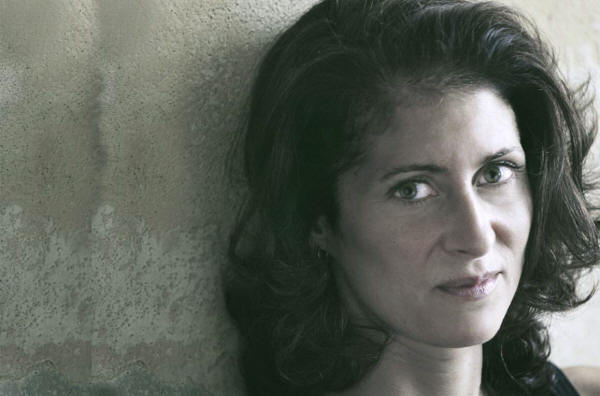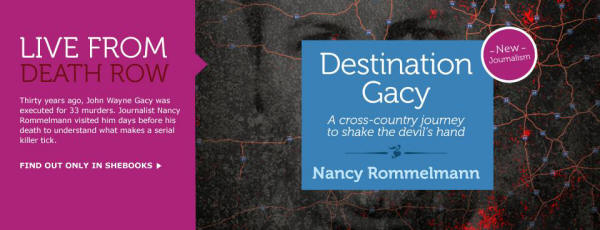You are reading the older HTML site
Positive Feedback ISSUE 73
Creativity and the Arts: Nancy
Rommelmann's New Article Destination Gacy Hits the Press!
[By way of introduction to PFO readers, Nancy Rommelmann is a Portland author, reviewer, and journalist. She's also a partner associated with Ristretto Roasters, and is married to a music-loving friend of mine, Din Johnson, the founder and owner of Ristretto Roasters. Din is a raving audiophile and a fine coffee connoisseur, producing the official PFO coffee blends (more on that soon!). All that by way of connection. Nancy is a very serious writer, from her roots in New York City and Los Angeles, and on to Portland, Oregon. Her bio is impressive: "Nancy Rommelmann's work appears in The Wall Street Journal, the LA Weekly, Reason, Byliner and other publications. She is the author of The Bad Mother, a novel (2011), The Queens of Montague Street, a memoir of growing up in 1970s Brooklyn that was excerpted in The New York Times Magazine, and the story collection, Transportation (2013). Destination Gacy, about her trip to interview serial killer John Wayne Gacy, was released as an ebook in May 2014. She is currently at work on To the Bridge, a book of narrative nonfiction about a filicide in Portland, Oregon." I like her writing quite a lot, and since she's a friend, and since we share an interest in creative work, I've decided to share an entré to her latest ebook here. I urge you to check Nancy's writing out. You can find a selection of her work at Amazon. What follows is a quick intro to the article Destination Gacy, followed by the link to purchase the full read. If you like it, jump on the link to the ebook over at Amazon. I'll let Nancy take it from here. Dr. David W. Robinson Editor-in-Chief, PFO]
How did you come to interview John Wayne Gacy and write about it? I was living in Hollywood in 1994, writing for these SoCal young dude magazines called bikini and Ray Gun. A video director I knew said, "Hey, Rommelmann, remember that party we went to at that guy Rick's house?" I did, vaguely. "Well," the director said, "he's going to visit John Wayne Gacy and he wants someone to write about it." Rick Gaez, who was 26, turned out to be a longtime pen pal of Gacy's, as well as a collector of his paintings. Why would Rick court and continue a relationship with a serial killer? Gacy was the most notorious killer of our time, his upcoming execution a mainstay of the nightly news. I saw the opportunity to explore the relationship between Rick and Gacy as fortuitous, as would be meeting Gacy, and trying to understand why a man convicted of torturing and murdering 33 young men and boys held such sway on the public imagination. I'd never written a feature longer than 1200 words and did not know where or how to pitch the story, but wound up selling it to Details magazine, 5000-words and expenses for the trip. Rick and I set out in a rented Ford Tempo, to drive from LA to Illinois. We knew each other not at all and he later confided to me that he'd packed a bag of psilocybin mushrooms in case I turned out to be a total drip. But we got on well, which was good, as the six-day trip turned into twelve when we were at first turned away from seeing Gacy. By the time I filed my story—which had grown to 9000-words—my editor had left Details and the new editor didn't want the piece. Gacy had been executed and it's crude but still true to say I felt as though I were dragging around a corpse. A friend helped me get it to the LA Weekly. They bought the piece and ran it at length. In a very real sense, the article, then entitled Going to Gacy, launched my career: within a month of it appearing, I had a column at the city magazine and was writing for the LA Times. The article did not, however, have long legs in itself, as it was published before the advent of the Internet; it's never been online. I've had so many people in the intervening years ask to read it. Now they can.
[Here's a quick excerpt from the article Destination Gacy….] I once read that serial killer John Wayne Gacy's brain was missing. Someone had stolen it. Following Gacy's execution, the brain had supposedly been extracted in hopes that probing the gray matter might shed some light on why killers kill. A later newspaper story reported that a forensic psychiatrist dissected his brain and still has it. Regardless of what actually happened to Gacy's grey matter, the public had an insatiable appetite for him while he lived; postmortem, we were still trying to get a piece of him. I've got mine: a pack of prison cigarettes and several photographs from when I visited Gacy in May 1994. The following week, the number one serial killer of that time was executed for 33 murders he committed throughout the 1970s, most of which included handcuffing young men and boys—some of whom were lured to Gacy's home for paid sex, others with the promise of employment in Gacy's contracting company—to a specially made board, then choking them to death with a knotted rope over a matter of hours or sometimes days. He stuffed 27 of the bodies into the crawl space beneath his Chicago-area home; two were found buried in his yard, four in a nearby river. Once a pillar of his Des Plaines, Illinois, community, Gacy denied the murders; in 1980, a jury found otherwise and sentenced Gacy to death. His fight to postpone the inevitable ended when the state of Illinois rejected his final appeal. The May 10 execution took place as scheduled. Before his death, family, friends, and people he had never met besieged Gacy with requests. One came from a 26-year-old musician and artist from Los Angeles, with whom Gacy had been corresponding for two years. On Gacy's urging, Rick Gaez made the 1500-mile journey to visit his pen pal "before it was too late." Rick asked me, a casual friend who also was a writer, to accompany him and document the encounter. I took a lot of flak for it. Wasn't I scared, wasn't I sickened? How could I explain I was looking forward to it? A crime-TV junkie, I could at the time have told you every schedule change America's Most Wanted had made in the previous two years. The re- enactments, especially the ones involving murder, drove me off the couch screaming at the perp's mug shot. No matter how heinous the crime, I looked. Meeting Gacy meant facing the horror I'd insofar only encountered on the nightly news, my front door double- locked. The anticipation made me feel as though I were filling with helium. Certainly, I had never knowingly courted a murderer. Going to Gacy meant walking into the den of the beast. Shackled, defanged, yes, but even under neutralized circumstances, the idea was electrifying. We took to the road to meet a killer. Driving out of Los Angeles in a rented Tempo, I try to remember Gacy's 1978 arrest. I vaguely recall some big white man in handcuffs, sheet-draped bodies bobbing past prying cameras. But it was a world away from New York City, where we'd recently been held hostage by local serial killer Son of Sam. Daring to stay out past midnight became a nervy drama; the killer could be anywhere. With our nightly lives hanging in the balance, the city crackled. Cruising through Death Valley, Rick agrees part of Gacy's allure was the proximity to danger. But he insists his initial contact with Gacy was predicated on something more tangible: the killer's art. "In 1992, I saw one of Gacy's paintings. It was odd, really bright and flat," Rick says. "I knew I wanted one, so I wrote him, and enclosed a picture of myself when I was 17, really clean-shaven and pretty and boyish, figuring that's about what he goes for." Rick knew he fit the profile of Gacy's victims—young, good-looking—and used this to entice Gacy into painting his portrait, which Gacy did, at a discount. But why would Rick, the product of a close-knit Catholic Latino family, a popular guy very much on the L.A. scene, keep communicating with a middle-aged sex offender and serial killer? "I've always been attracted to extremes, to deviants. Like my father said, 'You never know how cold the devil's hand is until you shake it.' When I got the opportunity to shake Gacy's hand, I took it. People think it's wrong, but that's a judgment call on their part. Why shouldn't I communicate with this guy? He's part of 20th-century history, and I'm getting to meet him." But why Gacy? Why not the pope? "The pope is boring, and anyway, meeting Gacy puts a little black in my life. Growing up in Orange County, life was comfortable, boring, suburban. Writing Gacy was like becoming a punker when we were kids, shouting 'Fuck you!' just to break the monotony." I ask how the letter-writing started. "He sent me a questionnaire, stuff like 'Favorite Movie,' and sent me his responses. I started to get a letter every month or so, and my girlfriend and I would just laugh, it was so weird. And all my friends thought it was wild; they couldn't believe I was writing this guy. They all wanted to, but nobody actually did. The people I know are talkers, no one's a walker. No one follows through with the things they say they're going to do. But I was really glad no one else wrote him. I think the novelty would've worn off if seven of my friends had said, 'Dude, I got a letter from him, too.'" Gacy letter to Rick, April 30, 1993: "I think what I enjoy about your letters is you're open and honest...you live in a town that is based on fantasy, so you're right, you have a lot of phony people, but some honest ones, too. Hell, I seem to have found one... Purchase the full article, Kindle edition, for only $2.99
|



